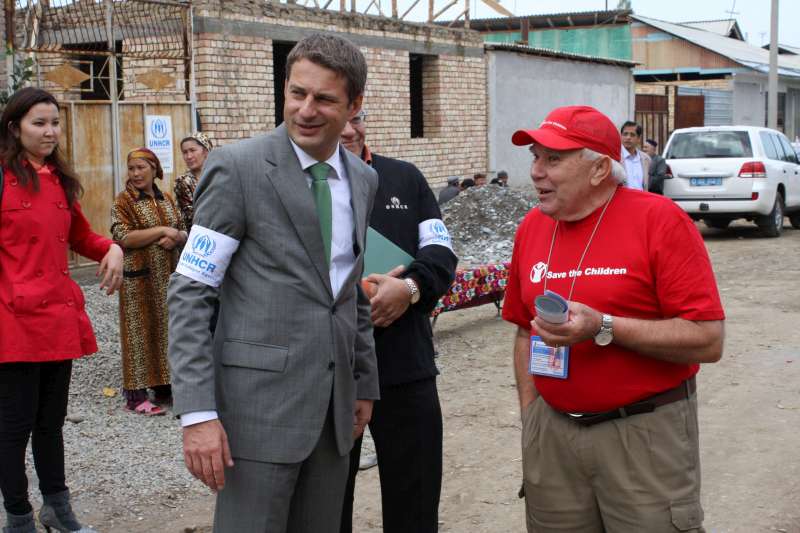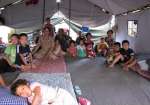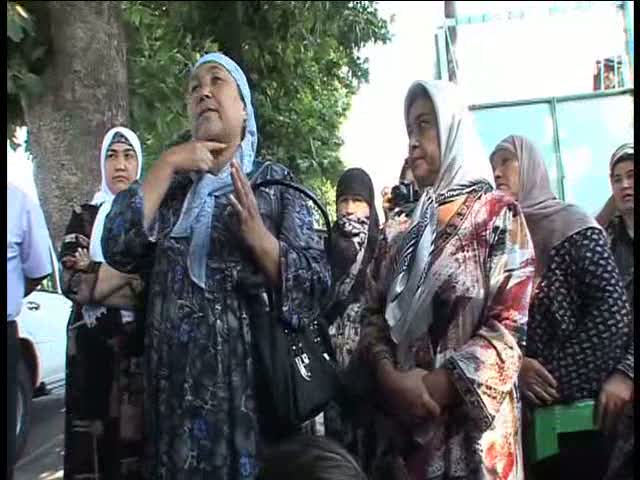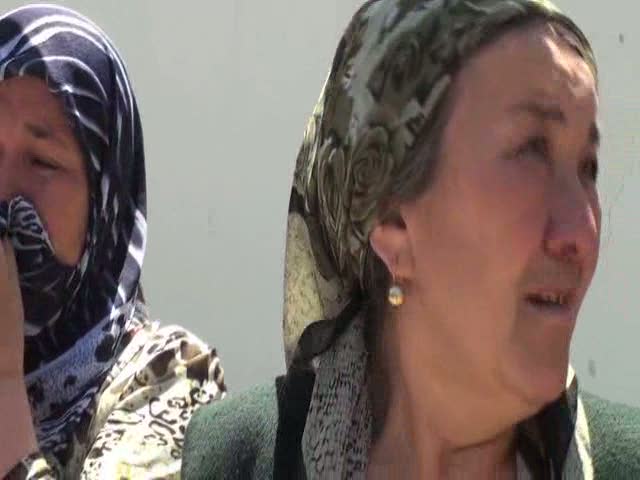Q&A: Contributing to peace-building in Kyrgyzstan
News Stories, 7 March 2011
GENEVA, March 7 (UNHCR) – In June last year, inter-ethnic clashes erupted in southern Kyrgyzstan. The days of violence, which followed the flight into exile seven weeks earlier of President Kurmanbek Bakiyev, forced almost 400,000 people to flee their homes, with many finding temporary sanctuary in neighbouring Uzbekistan. The UN refugee agency immediately swung into action to help the displaced and is now increasingly engaged in confidence-building and peace-building programmes. This is on top of UNHCR's regular work in support of thousands of refugees and stateless people in the Central Asian nation. Hans Schodder, UNHCR's representative in Kyrgyzstan, was in Geneva recently to seek donor support in 2011. He spoke to UNHCR Public Information Officers Babar Baloch and Leo Dobbs. Excerpts from the interview:
What happened in Kyrgyzstan last year?
Unfortunately, in June we saw inter-ethnic violence in the south of Kyrgyzstan, which started in Osh and then spread to Jalalabad. It went on for about four days. More than 400 people were killed and 2,000 injured. Residential neighbourhoods were attacked and looted; 2,000 private houses were damaged and 1,700 completely destroyed. About 75,000 people fled to Uzbekistan and some 300,000 were internally displaced in the Kyrgyz Republic.
By the end of June almost all of the refugees had returned from Uzbekistan. Most of the refugees and internally displaced eventually returned to their home neighbourhoods . . . Some remain internally displaced, living with host families because they don't yet dare to return to their neighbourhoods. And then quite a big number of people have gone abroad. There is an annual migration of able-bodied men and women to the Russian Federation and Kazakhstan in search of work. As a result of the violence, many more people than usual left.
What was UNHCR doing during the displacement crisis?
We delivered life-saving aid and conducted protection monitoring and interventions while people were on the move, during displacement and after their return. Our help allowed many people to return to their neighbourhoods. We distributed more than 2,500 tents, which many people pitched beside their ruined or damaged homes . . . Our protection activities and the provision of aid was important in helping to stabilize the situation and to provide the beginnings of durable solutions to these people.
We very quickly focused on shelter needs . . . by the end of July we had a shelter strategy developed in cooperation with the affected communities, our partners, the government and donors. By the end of August, we had received clearance from the authorities to start working in all the neighbourhoods. Then it was a race against time to finish before winter came in late November. We needed to construct 1,700 emergency shelters and there were loads of challenges, especially on local procurement. But we managed, working with three partners – the Danish Refugee Council, ACTED [Agency for Technical Cooperation and Development] and Save the Children – as well as the authorities.
At the same time, UNHCR protection teams, together with non-governmental organizations and government officials, worked in affected neighbourhoods and that allowed people to regain access to the authorities and to services.
We have also provided winter aid, including clothing, furniture and coal to more than 50,000 people,
And how is the situation now, especially in the south?
It is still precarious and volatile. There is still tension and mistrust between communities, as well as between communities and authorities, and everybody is apprehensive about what spring will bring. So we have an urgent need, and opportunity, to begin activities that will make everyone feel more confident about the future by the time spring starts.
What presence does UNHCR have in Kyrgyzstan?
We have three offices. We always had the head office in [the capital] Bishkek and a field office in Osh, but Osh has been the operations centre since June. Also in June, we opened a very small field office in Jalalabad. Before the emergency we had only two international staff, the head of our office in Osh and myself. Now we have 14 international staff. Before the emergency we had less than 20 national staff and now we have just over 50. Our office in Osh is now bigger than the one in Bishkek
What will these UNHCR staff members now be doing?
We will have to complete various protection activities, including restoration of documents, housing and property rights issues. That's very important because most of those affected are from urban areas . . . The human rights situation is still precarious, which means that we must continue supporting confidence-building measures, leading into peace-building and reconciliation.
There is a lot to be done to rebuild trust from both sides. That is something we've embarked on which is extremely important, to bring back peace and stability. The most vulnerable, above all, will need sustained humanitarian, livelihood and protection support.
And the economic prospects for the region have to be regenerated. There is only so much UNHCR can do, but we are launching community based quick-impact projects, including those promoting income-generation and livelihoods.
Tell us more about the protection monitoring
We were fortunate that we had kept a presence in southern Kyrgyzstan. We had very small, but quite successful, projects in both the protection of refugees and the prevention of statelessness. In responding to the protection needs of those affected by last June's violence, we were able to use – and beef up – the local structures we had in place before. Our projects to prevent and reduce statelessness, for example, had used mobile teams in mostly rural areas. These gathered lawyers from local NGOs as well as government officials and worked to help people obtain documents and get Kyrgyz citizenship. In response to the protection and reintegration challenges after the June violence, we were able to establish more of these joint mobile teams to provide protection services in conflict-affected urban areas.
You recently met donors in Geneva. What did you ask for?
Last year, over a six-month period we were able to make a swift and successful emergency response with solid donor support . . . We still have a lot of important work to do this year. We are asking donors for US$11.4 million for all activities in southern Kyrgyzstan during 2011. We can make a big difference with this. In addition, we need an additional US$500,000 for our 2011 refugee programme and US$250,000 for the statelessness programme.
We must continue and adjust our protection and humanitarian assistance programmes and continue to support the reintegration of the forcibly displaced. To help in the restoration of confidence and the rule of law, we also want to help revitalize and reconcile communities. Last but not least, we must continue to develop local capacities in a bid to reduce dependence on international support and engagement. Our confidence-building and peace-building activities are also aimed at early warning and conflict-prevention.
What about the refugees in Kyrgyzstan that you mentioned?
Most of the refugees are Afghan and the figures have gone down a lot over the years. We're talking about less than 900 asylum-seekers and refugees in the whole country. This compares to 20,000 during the [1992-1997] civil war in Tajikistan. Half of them we helped to repatriate; the other half we assisted in local integration – they got citizenship.
The current caseload is very small and not too difficult to manage. UNHCR is ready to help the new government and parliament to find solutions. Kyrgyzstan is a party to the 1951 UN Refugee Convention and has good national legislation and experienced institutions, while refugee protection is even enshrined in the constitution. Unfortunately, over the past few years there was a lack of political will and a hiatus in implementation. Government recognition rates for refugees shrank from 25 per cent to zero between 2005 and 2010. Now, there is a good opportunity to help Kyrgyzstan to honour its convention obligations on the protection of refugees. I am quite confident, because the figures are small and it's not a national security concern. Most of the refugees or asylum-seekers have been living in Kyrgyzstan for many years and are integrated in many respects. That said, some refugees cannot be integrated in Kyrgyzstan and, in these cases, we have been working successfully to look for alternative solutions, like resettlement.
And what about statelessness?
Too many people still face problems over documentation and citizenship, even after 20 years of independence from the Soviet Union. Statistics show 21,000 stateless people, but the figure is double this if you count all those who face problems with documentation and citizenship.
Because of the cumbersome bureaucracy, people need a lot of different papers to get access to their rights and it's sometimes difficult to get this documentation. We also have high migration. Sometimes the parents emigrate and take on another citizenship while their children remain behind. Many of them face citizenship problems when they are old enough to apply for passports. Most of those who lack documentation or citizenship are women and children, making them more vulnerable to exploitation and abuse in their families and communities.
A lot has been done in Kyrgyzstan on the prevention of statelessness, but there's a lot more that can and should be done. In 2007, citizenship legislation was adopted that is generally in line with international standards. In 2009, a high-level steering committee, co-chaired by the Presidential Commission and UNHCR, adopted a very good national action plan for the prevention and reduction of statelessness in Kyrgyzstan. Developments last year delayed its implementation. In 2011, we hope to reinvigorate the implementation of the action plan. This will include working with the new parliament on necessary changes to legislation and accession to the two universal statelessness conventions
In the meantime, we will continue to support local authorities, with the help of NGOs, to issue thousands of new birth certificates, passports and other documents. This will allow tens of thousands of mostly poor and disenfranchised people to get better access to services and their rights and make a real difference to their lives.




































